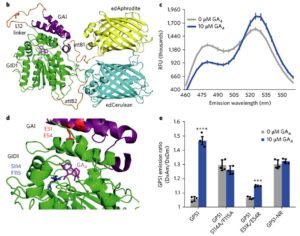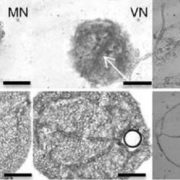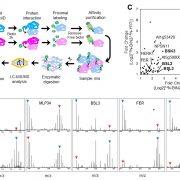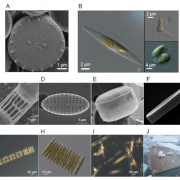In vivo gibberellin gradients visualized in rapidly elongating tissues
 Biosensors can reveal cellular or even sub-cellular distributions of hormones, greatly enhancing our understanding of hormone action. Rizza et al. have developed an in vivo, FRET-based gibberellin biosensor, GIBBERELLIN PERCEPTION SENSOR 1 (GPS1), that incorporates portions of two GA-binding proteins, (the receptor GID1 and a DELLA protein that GID1 interacts with when bound to GA) as well as Förster Resonance Energy Transfer (FRET) donor and recipient modules. In the presence of GA, a conformational change in GPS1 facilitates energy transfer which is measurable by an increase in ratio of acceptor emission over donor emission. Using GPS1 the authors showed a correlation of endogenous and exogenous GA levels with cell elongation, although the contributions of synthesis, transport and catabolism to the formation of these distribution patterns remains uncertain. They also showed evidence for PIF transcription factors in promoting GA accumulation in the dark, suggesting a “PIF positive feedback loop through GA signaling”. Nature Plants 10.1038/s41477-017-0021-9.
Biosensors can reveal cellular or even sub-cellular distributions of hormones, greatly enhancing our understanding of hormone action. Rizza et al. have developed an in vivo, FRET-based gibberellin biosensor, GIBBERELLIN PERCEPTION SENSOR 1 (GPS1), that incorporates portions of two GA-binding proteins, (the receptor GID1 and a DELLA protein that GID1 interacts with when bound to GA) as well as Förster Resonance Energy Transfer (FRET) donor and recipient modules. In the presence of GA, a conformational change in GPS1 facilitates energy transfer which is measurable by an increase in ratio of acceptor emission over donor emission. Using GPS1 the authors showed a correlation of endogenous and exogenous GA levels with cell elongation, although the contributions of synthesis, transport and catabolism to the formation of these distribution patterns remains uncertain. They also showed evidence for PIF transcription factors in promoting GA accumulation in the dark, suggesting a “PIF positive feedback loop through GA signaling”. Nature Plants 10.1038/s41477-017-0021-9.









